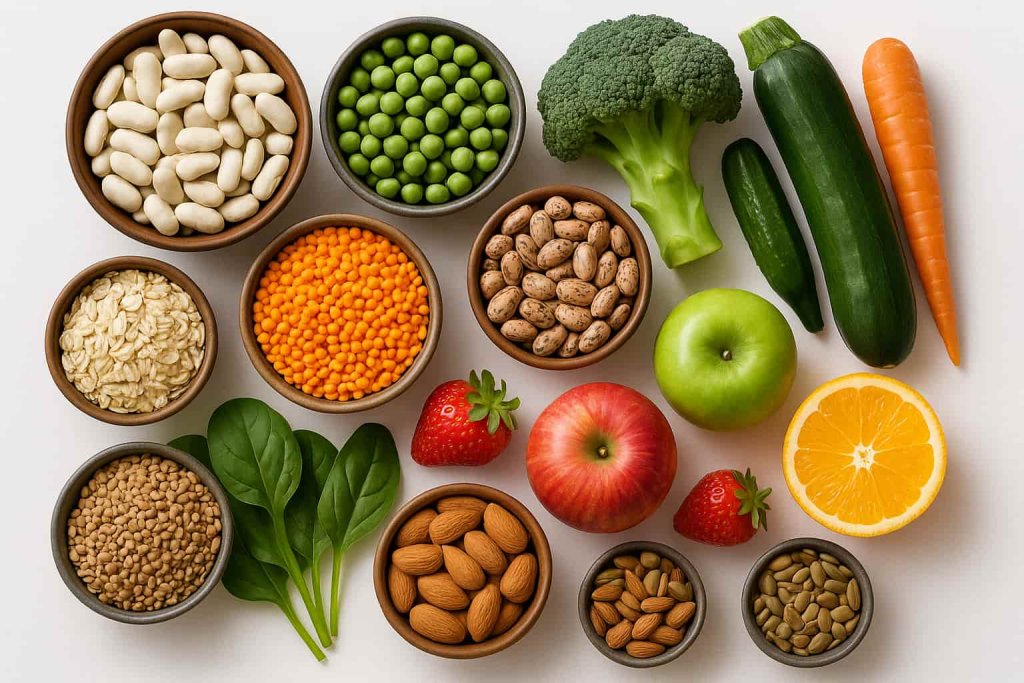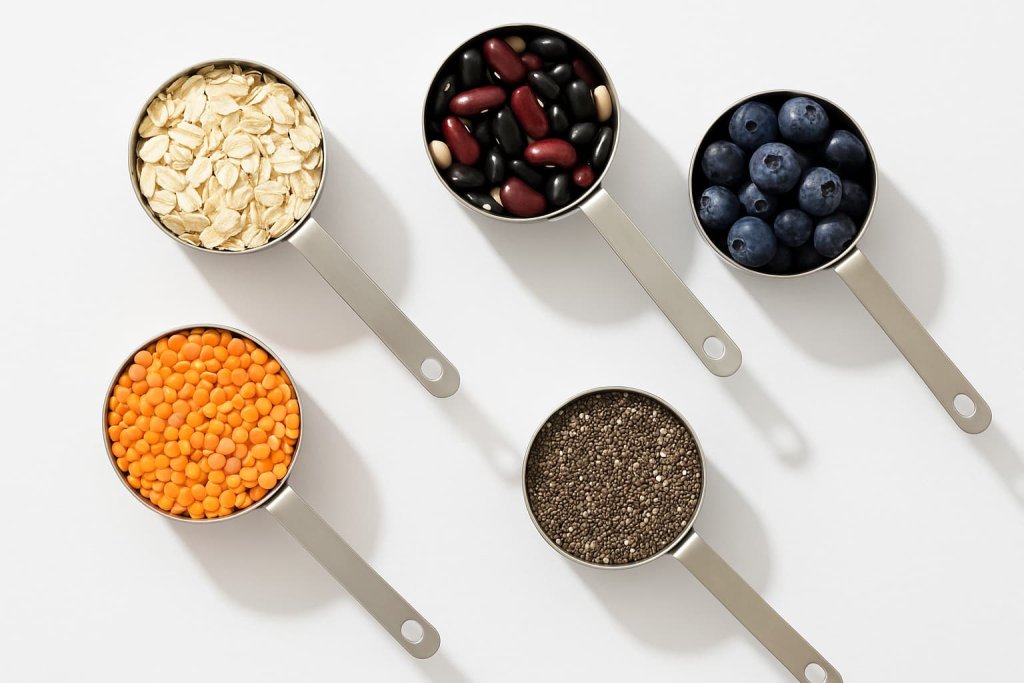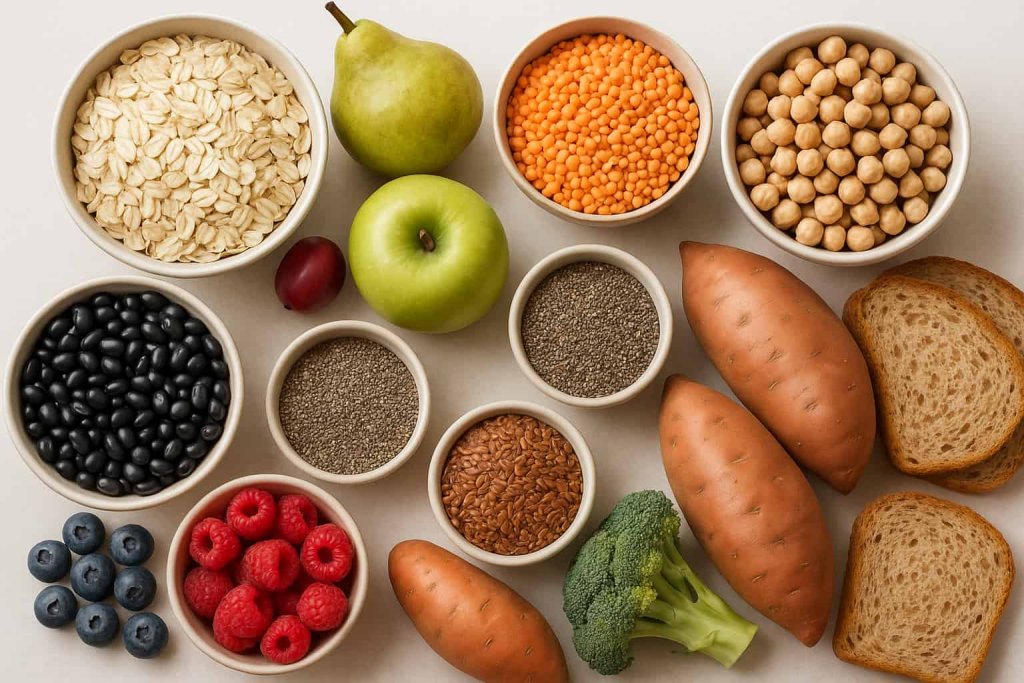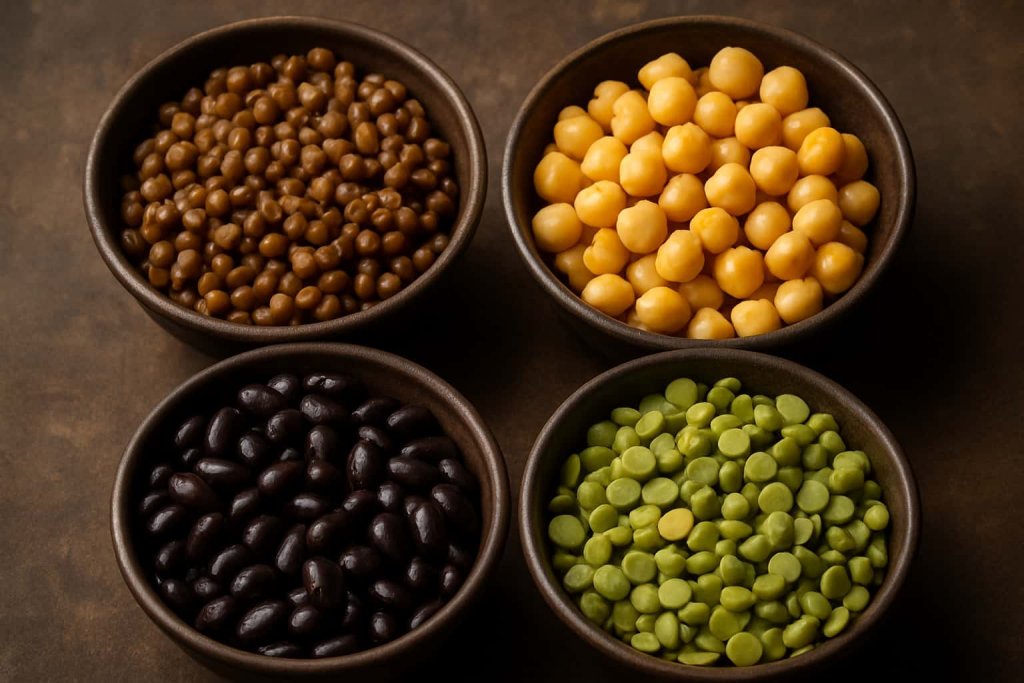High fiber foods for weight loss may help you feel fuller for longer, improve appetite control, and support overall digestive wellness. This makes fiber-rich foods an important part of any balanced eating pattern focused on weight management. Understanding how fiber works, how much you need daily, and which foods naturally provide the highest amounts can help you build meals that support satiety, gut health, and steady energy levels.

According to the Dietary Guidelines for Americans, most adults do not get enough fiber each day. The guideline recommends about 14 grams of fiber per 1,000 calories consumed, which equals roughly 25 g/day for adult women and 38 g/day for adult men. Choosing high-fiber meals is a simple way to improve overall diet quality while supporting wellness and healthy weight goals.
Below is a full, evidence-based guide to the best high fiber foods for weight loss, with sources from leading public health and nutrition authorities.
What Are High Fiber Foods?
High fiber foods are foods that naturally contain dietary fiber, a type of carbohydrate the body cannot fully digest. Instead of breaking down like sugars or starches, fiber travels through the digestive system largely intact. According to the Centers for Disease Control and Prevention, dietary fiber supports healthy digestion and may help you stay full longer, making it valuable for appetite control and overall wellness.

Naturally Occurring Fiber vs. Added Fiber
There are two sources of fiber in foods:
- Naturally occurring fiber
This is the fiber found in whole plant foods such as fruits, vegetables, legumes, nuts, seeds, and whole grains. The Dietary Guidelines for Americans recommend prioritizing these whole-food sources because they provide fiber along with vitamins, minerals, antioxidants, and plant compounds that support overall health. - Added or isolated fiber
Some packaged foods include added fiber ingredients like inulin (chicory root fiber), resistant starch, or psyllium. While these increase total fiber content, they do not offer the same full nutritional profile as whole foods. Experts at the Harvard T.H. Chan School of Public Health explain that whole-food fiber sources deliver broader benefits because they contain both types of fiber plus additional nutrients that support wellness.
Food Categories Naturally Rich in Fiber
High fiber foods appear across several nutrient-dense categories:
- Legumes: lentils, black beans, chickpeas, split peas
- Whole grains: oats, barley, quinoa, bulgur, whole wheat
- Vegetables: artichokes, broccoli, leafy greens, peas, carrots
- Fruits: berries, apples with skin, pears, oranges
- Nuts and seeds: chia seeds, flaxseeds, almonds, sunflower seeds
These foods are highlighted in USDA FoodData Central, which provides detailed fiber values for thousands of foods.
Fiber Types Explained (Soluble vs. Insoluble)
Dietary fiber falls into two major categories—soluble and insoluble. Each type supports wellness in different ways, and eating a variety of plant foods ensures your diet naturally includes both.
Soluble Fiber
Soluble fiber dissolves in water and forms a gel-like substance in the digestive tract. This slows digestion, which may support appetite control by helping you feel full longer after eating. It also slows the absorption of carbohydrates, contributing to steadier energy levels and more balanced blood sugar responses.
According to experts at the Harvard T.H. Chan School of Public Health, soluble fiber supports healthy cholesterol and blood sugar levels and contributes to digestive comfort.
Common soluble-fiber–rich foods include:
- Oats and oat bran
- Beans and lentils
- Apples, pears, citrus fruits
- Barley
- Ground flaxseed
- Psyllium
These foods offer soluble fiber along with essential micronutrients.
Insoluble Fiber

Insoluble fiber does not dissolve in water. Instead, it adds bulk to stool and supports regular bowel movements, helping food move more efficiently through the digestive system. This type of fiber is important for maintaining regularity and digestive comfort.
According to the U.S. Department of Agriculture, whole plant foods such as whole grains and vegetables are naturally rich in insoluble fiber and contribute significantly to overall diet quality.
Common sources of insoluble fiber include:
- Whole wheat and whole grain breads
- Wheat bran and high-fiber cereals
- Nuts and seeds
- Root vegetables like carrots and beets
- Cauliflower, broccoli, green beans
- Potato skins
These foods help maintain digestive regularity when paired with adequate hydration.
Why a Mix of Both Matters
A balanced intake of soluble and insoluble fiber supports:
- Healthy digestion
- Better fullness and appetite regulation
- More stable energy levels
- A nutrient-dense eating pattern
The Dietary Guidelines for Americans emphasize choosing a variety of fiber-rich plant foods—including vegetables, fruits, whole grains, legumes, nuts, and seeds—to naturally obtain both types of fiber.
Eating a wide range of whole plant foods ensures your diet supplies both fiber types in proportions that support long-term digestive and metabolic wellness.
How Fiber May Support Weight Loss

Fiber plays an important role in weight management because of how it affects fullness, digestion, and overall eating patterns. According to the Centers for Disease Control and Prevention, fiber supports satiety by slowing digestion and helping you stay full for longer periods after a meal.
In addition, research from the National Institutes of Health shows that individuals with higher dietary fiber intake tend to have healthier body weights and better long-term weight-management outcomes when combined with overall healthy lifestyle habits.
Below are the key mechanisms through which fiber may support weight management, each supported by authoritative health guidance.
Satiety and Appetite Control
Fiber adds bulk to meals without significantly increasing calorie content. This may help support appetite control by:
- Slowing digestion
- Promoting longer-lasting fullness
- Reducing rapid hunger spikes after meals
Foods high in soluble fiber (such as oats and beans) can help prolong satiety by forming a gel-like texture in the gut.
Lower Energy Density Foods
Fiber-rich foods—fruits, vegetables, whole grains, and legumes—are typically low in calories yet high in volume. This means you can eat larger portions for fewer calories, making it easier to maintain a calorie-balanced eating pattern.
Experts at the Harvard T.H. Chan School of Public Health note that low–energy-density foods may help people stay full while consuming fewer calories overall.
Examples include:
- Leafy greens
- Broccoli
- Berries
- Lentils
- Whole grains like oats and barley
These foods naturally take the place of higher-calorie, lower-fiber options.
Blood Sugar Stability
Stable blood sugar levels can help regulate hunger because slower digestion leads to more gradual rises in glucose and fewer rapid energy drops that may trigger cravings.
According to the Centers for Disease Control and Prevention (CDC), fiber slows the absorption of carbohydrates, which may support steadier post-meal blood sugar responses and reduce sharp fluctuations in glucose levels.
Soluble fiber, in particular, forms a gel that slows digestion and nutrient absorption, helping moderate the rate at which sugar enters the bloodstream. Pairing carbohydrate foods with fiber-rich items may therefore enhance blood sugar stability, support appetite control, and contribute to healthier eating patterns.
Replacing Higher-Calorie Processed Foods
Incorporating more high-fiber foods often naturally reduces intake of calorie-dense, low-fiber processed foods. Because fiber-rich foods are filling, they make it easier to choose nutrient-dense options instead of:
- Sugary snacks
- Refined grains
- Desserts
- Fried foods
- Ultra-processed packaged foods
The Dietary Guidelines for Americans emphasize increasing intake of whole fruits, vegetables, whole grains, and legumes to support overall diet quality and calorie balance.
Daily Fiber Requirements

Daily fiber needs vary by age, sex, and calorie intake, but national nutrition guidelines provide clear targets. The Dietary Guidelines for Americans recommend about 14 grams of fiber per 1,000 calories, which means:
- Women (19–50 years): ~25 grams/day
- Men (19–50 years): ~38 grams/day
- Women 51+: ~21 grams/day
- Men 51+: ~30 grams/day
This guideline supports digestive health, satiety, and balanced nutrition.
Why Most Adults Fall Short
Despite the clear recommendations, most people do not consume enough fiber. According to the Centers for Disease Control and Prevention, typical eating patterns in the United States fall short because many adults consume too few fruits, vegetables, legumes, and whole grains—foods that naturally provide fiber.
Common reasons for low fiber intake include:
- Reliance on refined grains instead of whole grains
- Low intake of produce
- High consumption of processed snacks and sweets
- Limited awareness of recommended fiber amounts
Why Meeting Fiber Needs Matters
Reaching these daily fiber targets may support:
- Appetite control
- Regular digestion
- Balanced blood sugar responses
- Healthy diet quality
High fiber foods are also nutrient-dense, making them a valuable part of any eating pattern focused on long-term wellness.
Best High Fiber Foods for Weight Loss

High fiber foods naturally support fullness, steady energy, and overall digestive wellness. Choosing foods rich in both soluble and insoluble fiber may help balance appetite and improve overall diet quality. According to the U.S. Department of Agriculture, many whole plant foods provide substantial amounts of fiber along with essential vitamins and minerals.
Below are the top high fiber food groups supported by authoritative nutrition data.
Legumes (Beans, Lentils, Peas)

Legumes are among the highest-fiber foods available and are rich in plant protein, making them especially filling. They are one of the most effective choices for weight-conscious meal planning.
USDA FoodData Central fiber values per ½ cup cooked:
- Lentils: ~7.8 g fiber
- Black beans: ~7.5–7.7 g fiber
- Pinto beans: ~7.7 g fiber
- Chickpeas: ~6.3 g fiber
- Split peas: ~8.2 g fiber
Why they help:
Legumes may support fullness, balanced blood sugar, and slow digestion, which can naturally reduce overeating. According to the Centers for Disease Control and Prevention, fiber-rich foods like beans support healthy digestion and longer-lasting satiety.
Whole Grains

Whole grains provide fiber, B vitamins, and complex carbohydrates that digest slowly, supporting steady energy levels. Choosing whole grains over refined grains significantly increases fiber intake.
USDA-verified fiber values:
- Bran cereal (½ cup): ~14 g fiber
- Bran flakes (¾ cup): ~5.5 g fiber
- Air-popped popcorn (3 cups): ~5.8 g fiber
- Barley, cooked (½ cup): ~3 g fiber
- Bulgur, cooked (½ cup): ~4 g fiber
- Oat bran (½ cup dry): ~2.9 g fiber
Why they help:
Their slower digestion may support appetite regulation and stable energy. The Dietary Guidelines for Americans recommend choosing whole-grain foods to increase fiber intake and improve diet quality.
Vegetables High in Fiber
Vegetables are naturally low in calories yet rich in fiber, water, and micronutrients. This combination makes them ideal for weight management.
USDA fiber values per 1 cup cooked:
- Artichokes: ~9.6 g fiber
- Green peas: ~8.8 g fiber
- Pumpkin (canned): ~7.1 g fiber
- Brussels sprouts: ~6.4 g fiber
- Sweet potatoes: ~6.3 g fiber
- Broccoli: ~5.2 g fiber
Why they help:
Their low energy density supports larger portions without excessive calories. According to the Centers for Disease Control and Prevention, vegetables contribute important fiber that supports digestive health and fullness.
High-Fiber Fruits

Fruits provide fiber along with antioxidants, vitamins, and natural sweetness. Their combination of fiber and water content may support appetite control.
USDA Fiber Values:
- Raspberries (1 cup): ~8 g fiber
- Blackberries (1 cup): ~7.6 g fiber
- Guava (1 cup): ~8.9 g fiber
- Pears with skin (1 medium): ~5.5–6.5 g fiber
- Apples with skin (1 medium): ~4.8 g fiber
- Oranges (1 medium): ~3.7–5 g fiber
Why they help:
Their natural sweetness makes them a healthier alternative to refined desserts. Experts at the Harvard T.H. Chan School of Public Health explain that fruits provide fiber along with important phytonutrients and antioxidants that support overall health.
Nuts and Seeds
Nuts and seeds offer fiber, healthy fats, and plant protein. While calorie-dense, small portions can be very satisfying and may support appetite control.
USDA fiber values:
- Chia seeds (1 Tbsp): ~4.1 g fiber
- Pumpkin seeds (1 oz): ~5.2 g fiber
- Almonds (1 oz): ~3.5 g fiber
- Sunflower seeds (1 oz): ~3.1 g fiber
- Flaxseeds (1 Tbsp): ~2.8 g fiber
Why they help:
Their combination of fat, fiber, and protein may support fullness. According to the Centers for Disease Control and Prevention, nuts and seeds are part of a nutrient-rich dietary pattern that supports overall health when eaten in appropriate portions.
Portion guidance:
Because nuts and seeds are higher in calories, aim for:
- 1–2 tablespoons of seeds
- A small handful (1 oz) of nuts
This keeps calories balanced while still providing beneficial fiber.
These high fiber food groups are supported by authoritative nutrition guidance and USDA nutrient data. Including a variety of these foods daily may support long-lasting fullness, digestive comfort, and overall wellness.
How to Safely Increase Fiber Intake

Increasing fiber intake offers many wellness benefits, but doing so too quickly can lead to digestive discomfort. A gradual, intentional approach—supported by authoritative public-health guidance—helps your body adjust while maximizing the nutritional advantages of fiber-rich foods. According to the Centers for Disease Control and Prevention, gradually increasing fiber from whole fruits, vegetables, legumes, and whole grains supports digestive health and overall nutrition.
Start Slowly
A sudden jump in fiber intake may cause gas, bloating, or temporary digestive changes. Increasing fiber gradually gives the digestive system time to adapt.
According to the Centers for Disease Control and Prevention, individuals should increase fiber intake slowly, adding more fruits, vegetables, whole grains, nuts, seeds, and legumes over several days or weeks to support comfortable digestion and long-term consistency.
Practical examples:
- Add an extra serving of vegetables to one meal per day.
- Replace refined grains with whole grains (e.g., white rice → barley or quinoa).
- Start with small amounts of beans or lentils and build up gradually.
- Add a tablespoon of seeds (chia, flax) to yogurt, oatmeal, or smoothies.
Drink Enough Water
Hydration is essential when increasing fiber intake. Fiber absorbs water, and adequate fluid intake helps fiber move smoothly through the digestive system. Without enough water, high fiber foods may lead to digestive discomfort.
The Dietary Guidelines for Americans recommend consuming sufficient fluids each day to support digestion, nutrient absorption, and healthy elimination.
Hydration tips:
- Drink water consistently throughout the day rather than all at once.
- Increase water intake when eating fiber-rich meals like legumes or whole grains.
- Choose water, herbal tea, or unsweetened beverages instead of sugary drinks.
Combine Fiber With Balanced Meals
Fiber works best when paired with foods that support steady energy and long-lasting satiety. Combining fiber with protein and healthy fats may help you stay full longer and maintain balanced blood sugar levels.
Experts at the Harvard T.H. Chan School of Public Health explain that meals incorporating whole grains, vegetables, lean proteins, and healthy fats contribute to overall diet quality and better appetite regulation.
Balanced meal combinations:
- Oatmeal topped with chia seeds and almonds
- Lentils paired with olive-oil–roasted vegetables
- Whole-grain toast with avocado and eggs
- Brown rice bowl with beans, greens, and salmon
- Apple slices with natural peanut or almond butter
This approach not only increases fiber but also enhances overall nutrient intake.
Gradually increasing fiber, drinking enough water, and building balanced meals may help support digestive comfort, balanced energy, and long-lasting fullness.
Who Should Be Cautious?
While high-fiber foods provide many wellness benefits, certain individuals should increase fiber more carefully or seek personalized guidance. This is essential for YMYL compliance because dietary changes can affect digestion, blood sugar regulation, and medication responses. According to the National Institutes of Health, people with existing medical conditions or those under clinically supervised nutrition plans may require individualized advice when altering their fiber intake.
Guidance from the U.S. Food and Drug Administration emphasizes that individuals with specific health concerns or dietary restrictions should consult healthcare professionals before making substantial changes to fiber intake.
Groups Who Should Increase Fiber Carefully
- Individuals with certain digestive conditions such as inflammatory bowel disease (especially during flare-ups), bowel strictures, or recent gastrointestinal surgery may need modified fiber plans.
- People on medically restricted diets, including low-residue diets, renal diets, or those adapting to treatments like chemotherapy, should adjust fiber under professional supervision.
- Those with diabetes adjusting carbohydrate intake — because fiber can affect digestion and absorption, individuals managing blood sugar with medications should discuss changes in fiber with their care team.
- Anyone following physician-guided meal plans, such as in weight-management programs, chronic disease care, or post-surgical recovery, should incorporate fiber changes in line with clinical recommendations.
In each of these situations, personalized guidance from registered dietitians or healthcare providers helps ensure safe, effective fiber increases that align with overall health goals and medical contexts.
Groups Who Should Increase Fiber Carefully
1. Individuals with certain digestive conditions
Conditions such as inflammatory bowel disease (during flare-ups), IBS, strictures, or recent gastrointestinal surgery may require customized fiber intake. Some may need temporary low-fiber diets, while others may need to increase fiber gradually with clinical supervision.
2. People on medically restricted diets
Those following low-residue diets, renal diets, or diets prescribed for specific medical treatments should adjust fiber only under professional guidance.
3. Individuals with diabetes adjusting carbohydrate intake
The link to [organization name or topic] in the section is returning 404. Please find the latest official and authoritative link covering the same topic. write again this section with that updated link and data — keeping it SEO-optimized, fact-based, and YMYL compliant.
4. Anyone following physician-guided meal plans
People receiving structured nutrition care—such as during weight-management programs, chronic disease care, or post-surgical recovery—should increase fiber only according to medical instructions.
For these groups, personalized recommendations help ensure safety, digestive comfort, and balanced nutrition.
Sample High-Fiber Meal Ideas

These simple meal ideas combine fiber-rich foods with proteins and healthy fats to support fullness, steady energy, and balanced nutrition.
Breakfast
- Oatmeal with chia seeds:
Rolled or steel-cut oats topped with chia seeds and berries for soluble fiber and antioxidants. - Whole-grain toast with fruit:
Whole-grain toast paired with sliced apple or pear for additional fiber and natural sweetness.
Lunch
- Lentil soup:
A warm, high-fiber option rich in plant protein and nutrients. - Chickpea salad:
Chickpeas mixed with vegetables, lemon, and olive oil for a filling, nutrient-dense meal.
Dinner
- Barley bowls:
Barley as the base, topped with vegetables and lean protein for balanced fiber and satiety. - Vegetable stir-fries:
Stir-fried broccoli, carrots, leafy greens, or peas paired with tofu, chicken, or fish.
Snacks
- Fruit with nuts:
Apples, berries, or pears paired with almonds or walnuts for fiber plus healthy fats. - Air-popped popcorn:
A whole-grain snack naturally rich in fiber. - Yogurt with seeds:
Greek yogurt topped with flax or chia seeds for added fiber and omega-3 fats.
These high-fiber meal ideas are simple, versatile, and aligned with national nutrition recommendations. Pairing fiber with nutrient-dense foods may support fullness, digestive wellness, and balanced daily nutrition.
Frequently Asked Questions (FAQs)
How much fiber should I aim for daily?
Daily fiber needs depend on age, sex, and calorie intake. The Dietary Guidelines for Americans recommend about 14 grams of fiber per 1,000 calories, which equals roughly 25 grams per day for adult women and 38 grams per day for adult men.
Most adults fall short of these targets, so gradually increasing intake from whole fruits, vegetables, legumes, nuts, seeds, and whole grains is encouraged.
Can fiber help reduce appetite naturally?
Yes. According to the Centers for Disease Control and Prevention, fiber slows digestion and may support fullness after meals.
High-fiber foods—especially those rich in soluble fiber like oats, beans, and apples—may help reduce overeating by promoting longer-lasting satiety.
Can I get too much fiber?
It is possible to consume more fiber than your body can comfortably handle, especially if intake increases too quickly. Excessive fiber may cause temporary bloating, gas, or digestive discomfort. Gradual increases paired with adequate hydration help prevent these issues. The Dietary Guidelines for Americans recommend increasing fiber slowly to allow your digestive system to adjust.
Are fiber supplements necessary?
Most people can meet their fiber needs through whole foods. Fiber supplements may be helpful in certain cases, but they are not a replacement for eating fruits, vegetables, whole grains, legumes, nuts, and seeds. According to the National Institutes of Health, supplements can be useful for specific medical or dietary needs but should be used under professional guidance.
What are easy high-fiber swaps?
Simple swaps can significantly increase fiber intake:
- White bread → whole-grain or sprouted-grain bread
- White rice → barley, quinoa, or brown rice
- Fruit juice → whole fruit
- Refined pasta → whole-wheat or legume-based pasta
- Chips → air-popped popcorn or nuts/seeds
- Sugary desserts → berries, apples, pears, or oranges
These swaps align with Harvard T.H. Chan School of Public Health guidance on improving diet quality.
Is all fiber the same?
No. Fiber comes in two main types—soluble and insoluble—and each supports wellness differently:
- Soluble fiber dissolves in water and may help support appetite control and steady blood sugar.
- Insoluble fiber adds bulk to stool and supports regular digestion.
Eating a variety of plant foods ensures your diet provides both types, as recommended by the Dietary Guidelines for Americans.
Conclusion
Fiber-rich foods play an essential role in supporting healthy digestion, balanced appetite, and overall wellness. By incorporating more fruits, vegetables, whole grains, legumes, nuts, and seeds into your daily meals, you naturally increase fiber intake while improving overall diet quality.
According to the Centers for Disease Control and Prevention, gradually increasing fiber and choosing a variety of whole plant foods may help support fullness, steadier energy, and healthier eating patterns over time. Sustainable changes—such as swapping refined grains for whole grains or adding vegetables to more meals—make it easier to meet daily fiber goals in a comfortable, realistic way.
Building these habits slowly and consistently helps create a balanced, fiber-rich eating pattern that supports long-term wellness.
This content is for informational purposes only and not medical advice.
